The 80s is widely viewed as a dark time for style, but honestly it’s one of my favorite fashion eras. Any decade that could inspire such excess on all fronts is immediately interesting to me.
I’m going to explore the highs and the lows of the decade. Of course, as with all decades, there were many style subgenres, so I naturally won’t be able to focus on all of them. But I’ll do my best to paint an overall picture of the 1980s vibes.
I’ll also mainly be focusing on British and American fashion, though I’m sure there were incredible trends started elsewhere during the decade too. From spandex to power suits to mullets, the 80s gave us an incredible amount of variation. So let’s delve in to some of the key styles that were definitively 80s.
Cultural Climate of the 1980s
Firstly, I’ll provide a very brief overview of the cultural climate in this decade, so we can understand how many of the over-the-top trends were born.
Differing from the 1960s and 70s, the 1980s was known for consumerism and materialism. With yuppy attitudes and access to quickly developing technology, making the decade feel faster and flashier than those that came before it.
Political Landscape
In the UK, the Tories were in power with the highly controversial Margaret Thatcher as Prime Minister. Thatcher is known for implementing the right to buy scheme, helping council house tenants and those less well-off to buy their homes, as well as helping to back entrepreneurial ventures.

She also pushed for the privatization of industries, and though many of her policies were not without repercussions, she did massively impact the British economy.
People found themselves being able to move across a previously pretty impenetrable class system, and this impacted people’s attitudes towards consumerism. Things became within reach that previously weren’t, and we see this attitude impact the style and materialism of this decade.
Economic Boom
Across the pond, the Republicans were in power led by President Ronald Reagan. Reagan’s economic policy, becoming known as Reaganomics, brought about one of the biggest economic booms in U.S history.
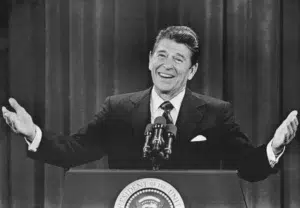

Yuppie Style: The Rise of Materialism
Defining the Yuppie
Let’s start with the yuppie image which was tied directly to the economic booms that were happening during this time. Yuppie stands for young urban professional or young upwardly mobile professional, with a clean-cut preppy style being associated with this term.
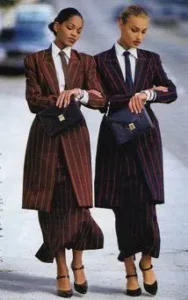
The yuppies wanted to exude money and success, and this was evident in their clothing. The cultural climate that’s enabled a fast life and fast money gave rise to displays of wealth amongst the young that differed greatly from the decades prior.
Gone were the days of the youths being all about free love and sticking it to the man. Instead, the youths were becoming the man, jobs in banks and offices were becoming much more readily available, and the style reflected these roles.
Yuppie Fashion
Shoulder-padded suit jackets, high-waisted pleated trousers, and Rolexes were all the rage during work hours, to then be swapped out on weekends spent socializing and networking.
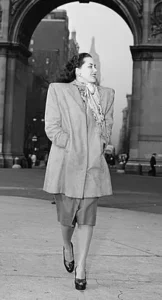
Their Goal
The goal was to look preppy and well-groomed, giving off an aura of accomplishment and wealth. As the decade continued, yuppie was increasingly used as a pejorative term, but until the mid-80s, the yuppies were in large supply. Optimism, opportunism, and a certain egotism were key to the image and have become indicative of the 80s money culture.
Corporate culture and corporate styles were part of the zeitgeist and have gone on to determine our attitudes to professional life for years after. But much like today, people in the 1980s weren’t only interested in looking financially successful
Fitness Craze and Workout Culture
Exercise Boom
There was an exercise boom during the 80s that coincided with the popularization of athleisure wear. The 80s was certainly an era of extremes, with cocaine fueling insane work lives and workout culture allowing you to erode size away the bad habits.This picture is taken from newyork times.
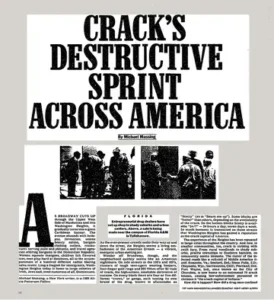
Spandex and Shell Suits
Spandex was the material of the moment, ideal for showing off the toned body that you were working so hard to maintain through aerobics and jazzercise.

These items often came in the boldest neon colors imaginable, with neon also becoming part and parcel of the 80s aesthetic. The decade was many things, but subtle was not one of them.
In addition to the extreme bodycon styles of workout gear, we also saw the increasing popularity of the shell suits. All the big sports brands were making them in bold colors and patterns, true to the 80s vibe. Made from shiny nylon, they certainly made a statement.
 New Romantics Movement: Decadence and Drama
New Romantics Movement: Decadence and Drama
Let’s switch gears now and take a look at the styles that were directly influenced by the various music scenes that were born in the 80s. Many of the biggest style icons during this time were musicians from Adamant to Madonna to Grace Jones.
Of course, there were many music subgenres that popped up during this era, so I won’t be able to cover them all, but I will try to look at those that I found to be the most influential.
Introduction to the New Romantics
This movement was prominent early on in the decade and eventually faded out by the mid-80s, but it left behind a distinctive legacy. Becoming immediately identifiable by their combination of bold makeup and flamboyant clothing, the New Romantics were anything but understated.

Fashion of the New Romantics
Frilly shirts, red lipstick, leather trousers, military jackets, and pirate-style clothing were all key components of the New Romantic attire, with those in the movements really leaning into the androgyny that these outfits allowed.
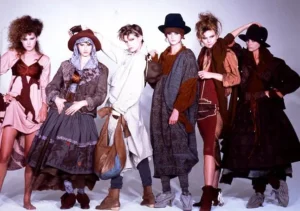
The combination of rapidly developing technology, sexual freedom, and the changing economy led to an over-the-top glamorous image that has become a key part of 80s history.
Hair Metal Bands: Glamour and Volume
Hair Metal Phenomenon
Equally as dramatic but entirely different, the 80s also saw the popularization of hair metal bands. Being referred to as hair metal was often seen as derogatory at the time, with the bands in this movement often preferring to be categorized as glam rock instead despite being pretty different from the glam rock bands of the decade prior.
As the name hair metal suggests, the voluminous hair of the band members was a key part of their image. Both men and women had long, often permed, and frequently backcombed hair perfect for whipping around on stage for added drama.
Fashion of Hair Metal
Clothes-wise, everything was as over the top as one could expect from any style movement birthed in this decade. I’m going to group in some bands that would be considered less hair metal and just regular metal here as the clothing choices were often very similar.
Think Bon Jovi, Guns and Roses, Def Leppard, Vixen, Whitesnake, and Quiet Riot amongst many, many others. The uniform for these bands often consisted of some combination of leather trousers, acid wash denim, bandanas, denim vests, wrist cuffs, and studs on absolutely everything.
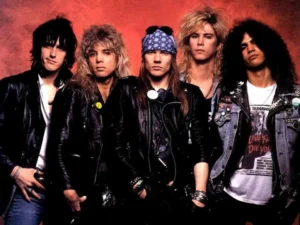
Hip-Hop Scene: Blending Sportswear with Luxury
Golden Age of Hip-Hoplet’s take a look at the booming hip-hop scene that took off in this decade. Groups such as Run DMC, Public Enemy, Beastie Boys, and NWA were enormously successful and quickly garnered a cult following.
Now referred to as Golden Age hip-hop, America produced some of the biggest names in this genre during this era, with many of the artists originating from New York.
The hip-hop scene merged sportswear styles with luxury and excess, becoming the blueprints for many of the sport luxe styles that permeated the 1990s.
Hip-Hop Fashion
Tracksuits, bucket hats, and Air Jordans were frequently worn by stars such as LL Cool J and Slick Rick, who also helped to popularize rope chains and four-finger rings.

Salt and Pepper and Eric B and Rakim were amongst those that famously worked with Dapper Dan using his pieces in their artwork and music videos.
His work perfectly exemplified the crossover between casual streetwear silhouettes and the performativity of wealth that the hip-hop scene became known for, and he undoubtedly had an influence on the direction that large fashion houses have moved in since.
It’s now very common to see designer bucket hats, track suits, and costume jewelry, but Dapper Dan made it so that it was within reach of all the styles I’ve looked at so far.
Indie Scene: Effortless Cool and Counterculture
Introduction to Indie Style
The last music-related style group that I’ll look at today is the indie scene, the most understated of the styles looked at thus far. The indie scene was known for its appearance of nonchalance and lack of polish.
This, along with the looks popularized by the hip-hop scene, has had influence that has continued until the present day, with stores such as Urban Outfitters still trying to capitalize on this vibe.
A few of the key bands within this movement were The Smiths, Echo and The Bonnie Men, and The Jesus and Mary Chain. The aesthetic of these groups was by and large effortless, laid back, and a far cry from the costume-like outfits of the New Romantics or metal fans. Politically, the indie groups were providing a counterculture to follow for those who did not feel represented by Thatcher’s Britain.
Fashion of the Indie Scene

The popularity of this style of clothing has prevailed, with youths who feel as though they don’t fit in or are misunderstood by their generation often turning to Johnny Marr or Ian McCulloch for inspiration.
Being one of the most wearable styles that came out of the 80s, it’s not surprising that it is still seen everywhere.
Honorable Mentions and Cultural Icons
John Hughes Movies
There are so many more style groups that I’d love to look at, but lastly, I’ll just give some honorable mentions to a few key sources of inspiration. You can’t think of the 1980s without thinking of John Hughes movies, with these really giving us an insight into the style at the time.
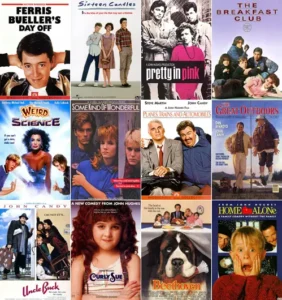
Jerry Seinfeld’s Style
Think also back to the early seasons of Seinfeld with Jerry really showing us what ordinary people wore.
Princess Diana’s Influence
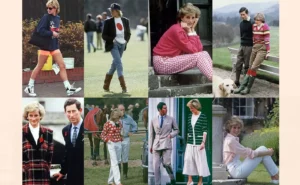
Conclusion
1980s was a decade defined by excess, innovation, and diverse fashion trends. From the rise of yuppie culture to the flamboyance of the New Romantics movement, and the flashy styles of hair metal bands to the laid-back indie scene, the 80s offered something for everyone.
This era reflected a cultural shift towards consumerism, materialism, and rapid technological development, influencing fashion in both British and American contexts.
While some trends have faded into obscurity, others, like 80s hip-hop fashion, continue to inspire contemporary styles. As we reflect on the bold and vibrant fashion of the 1980s, it’s evident that its influence still resonates in today’s fashion landscape, making it a truly unforgettable era in style history.


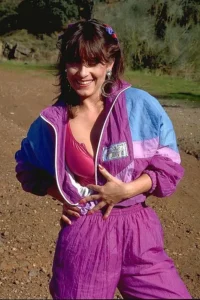 New Romantics Movement: Decadence and Drama
New Romantics Movement: Decadence and Drama